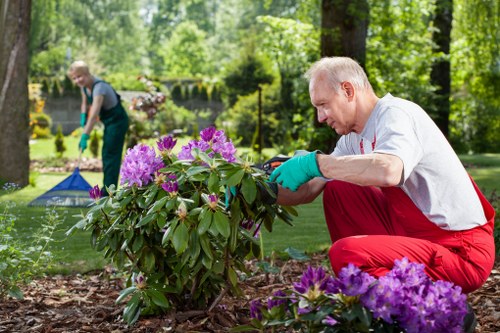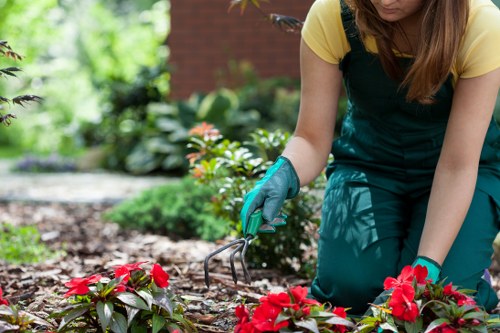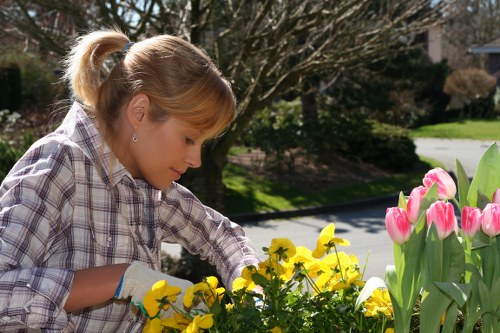Stump Grinder in Landscape Gardeners: A Comprehensive Guide

Introduction to Stump Grinding
When it comes to maintaining a beautiful and healthy landscape, removing tree stumps is an essential task. **Stump grinders** have become invaluable tools for landscape gardeners, offering an efficient and effective way to eliminate unwanted stumps. Whether you're a professional landscaper or a homeowner looking to enhance your garden, understanding the role of stump grinders can make a significant difference.
Stump grinding involves using specialized machinery to break down the remaining tree trunk after the tree has been cut down. This process not only improves the aesthetics of your garden but also prevents potential hazards and promotes healthier plant growth.
In this article, we will delve deep into the importance of stump grinders in landscape gardening, exploring their benefits, types, usage techniques, and best practices. By the end, you'll have a comprehensive understanding of how stump grinders can transform your outdoor space.

The Importance of Stump Grinding in Landscaping
Removing tree stumps is crucial for several reasons. **First and foremost,** stumps can be unsightly, detracting from the overall beauty of your landscape. They can dominate the visual space, making your garden appear cluttered and less inviting.
Secondly, stumps can pose safety hazards. They are trip and fall dangers, especially in areas frequently accessed by children and pets. Additionally, stumps can attract unwanted pests such as termites and ants, which may spread to other parts of your property.
Furthermore, stumps can interfere with future landscaping projects. If you plan to plant new trees, shrubs, or install features like patios and pathways, the existing stumps can complicate and limit your options.

Benefits of Using Stump Grinders in Landscape Gardening
**Stump grinders** offer numerous advantages over traditional stump removal methods like manual digging or chemical treatments. Here are some key benefits:
- Efficiency: Stump grinders can remove stumps quickly, saving time and labor.
- Effectiveness: They ensure complete removal of the stump down to the roots, preventing regrowth.
- Safety: Using machinery reduces the risk of injury compared to manual removal methods.
- Versatility: Stump grinders can handle various stump sizes and types of wood.
- Environmental Friendly: Unlike chemical treatments, stump grinding does not involve harmful substances.

Types of Stump Grinders
There are primarily two types of stump grinders used in landscape gardening:
- Gas-Powered Stump Grinders: These are heavy-duty machines suitable for large-scale projects. They offer more power and are ideal for professional landscapers who handle multiple stump removals daily.
- Electric Stump Grinders: These are lighter and more suitable for smaller gardens or residential use. They are quieter and produce fewer emissions, making them environmentally friendly.
Choosing the right type depends on the size of your project, budget, and specific requirements.

How to Use a Stump Grinder Safely and Effectively
Operating a stump grinder requires attention to safety and adherence to best practices. Here are steps to ensure effective stump grinding:
- Preparation: Clear the area around the stump of any debris, rocks, or obstacles. Ensure there are no underground utilities nearby.
- Protective Gear: Always wear appropriate safety equipment, including gloves, goggles, and sturdy footwear.
- Machine Setup: Position the stump grinder so that the cutting wheel is directly over the center of the stump. Ensure the machine is stable and secure.
- Grinding Process: Start the grinder and slowly lower the cutting wheel onto the stump. Move the grinder in a back-and-forth motion to effectively grind the wood.
- Depth Control: Gradually increase the depth of the grinder to avoid overloading the machine and ensure a smooth finish.
- Cleanup: After grinding, remove the wood chips and debris. You can use the chipped wood as mulch for your garden.

Maintenance Tips for Stump Grinders
To ensure the longevity and optimal performance of your stump grinder, regular maintenance is essential. Here are some tips:
- Regular Cleaning: After each use, clean the machine to remove any dirt, sap, or debris that may accumulate.
- Blade Inspection: Frequently check the cutting blades for dullness or damage. Sharp blades are crucial for efficient grinding.
- Oil Levels: Monitor and maintain proper oil levels as per the manufacturer's instructions to keep the engine running smoothly.
- Storage: Store the stump grinder in a dry, sheltered location to protect it from the elements.

Choosing the Right Stump Grinder for Your Needs
When selecting a stump grinder, consider the following factors to ensure it meets your specific requirements:
- Size of Stumps: Larger stumps require more powerful grinders with bigger cutting wheels.
- Frequency of Use: Heavy usage demands a more durable and high-capacity machine.
- Budget: Balance your budget with the features and capabilities you need. Sometimes, investing in a higher-quality grinder can save money in the long run.
- Portability: If you need to move the grinder around your property frequently, consider models that are lightweight and easy to transport.

Environmental Considerations of Stump Grinding
**Sustainability** is increasingly important in landscaping. Stump grinding is an environmentally friendly method compared to other removal techniques. Here’s why:
- No Chemicals: Unlike chemical treatments that can harm the soil and water sources, stump grinding relies solely on mechanical means.
- Reuse of Wood Chips: The byproduct of grinding, wood chips, can be repurposed as mulch, providing nutrients to your plants and reducing waste.
- Prevents Erosion: Removing stumps helps prevent soil erosion, especially on slopes and garden beds.

Cost-Effective Landscaping with Stump Grinders
Investing in a stump grinder can lead to long-term savings in your landscaping projects. Here’s how:
By eliminating the need for chemical treatments or extensive manual labor, stump grinders reduce overall costs associated with stump removal. Additionally, the ability to repurpose wood chips as mulch saves money on purchasing gardening materials.
Furthermore, removing stumps promptly prevents potential damage to property structures and reduces the risk of pest infestations, which can be costly to address.

Professional vs. DIY Stump Grinding
Deciding between hiring a professional or undertaking stump grinding yourself depends on several factors:
- Expertise: Professionals have the necessary experience and equipment to handle stump grinding efficiently and safely.
- Time and Effort: DIY stump grinding can be time-consuming and physically demanding, especially for large or multiple stumps.
- Equipment Costs: Purchasing or renting a stump grinder can be expensive. Hiring a professional may be more cost-effective for occasional use.
- Safety: Professionals are trained to operate machinery safely, minimizing the risk of accidents.
If you're unsure about handling stump grinding yourself, consulting a professional landscape gardener can ensure the job is done correctly and efficiently.

Integrating Stump Grinding into Your Landscaping Plan
Incorporating stump grinding into your overall landscaping strategy can lead to a more cohesive and aesthetically pleasing outdoor space. Here’s how:
- Design Flexibility: Removing stumps frees up space for new plantings, structures, or features like patios and walkways.
- Soil Health: Grinding stumps improves soil aeration and drainage, promoting healthier plant growth.
- Visual Appeal: A stump-free landscape looks well-maintained and inviting.

Common Mistakes to Avoid When Using a Stump Grinder
To ensure successful stump grinding, be aware of common pitfalls and how to avoid them:
- Ignoring Safety Precautions: Always prioritize safety by wearing protective gear and following manufacturer guidelines.
- Improper Machine Handling: Avoid excessive force or uneven grinding to prevent damaging the equipment.
- Neglecting Maintenance: Regularly maintain your stump grinder to ensure it operates efficiently and lasts longer.
- Overlooking Site Preparation: Properly prepare the area by removing debris and ensuring clear access for the grinder.

Enhancing Garden Health Post Stump Grinding
After stump grinding, it's essential to take steps to maintain and improve the health of your garden:
- Mulching: Use the wood chips from grinding as mulch to retain soil moisture and suppress weeds.
- Soil Testing: Assess the soil quality and make necessary amendments to support new plant growth.
- Planting: Consider planting new trees or shrubs in the cleared area to enhance biodiversity and aesthetics.
- Watering and Fertilizing: Ensure new plants receive adequate water and nutrients for healthy development.
Taking these steps can help rejuvenate your garden, making it more vibrant and resilient.

Technological Advances in Stump Grinding
The stump grinding industry has seen significant technological advancements, enhancing efficiency and user experience:
- Improved Blade Design: Modern grinders feature more durable and sharper blades, allowing for faster and more precise grinding.
- Enhanced Mobility: Newer models are designed to be more maneuverable, making it easier to navigate tight spaces.
- Emission Control: Gas-powered grinders now come with better emission control systems, reducing environmental impact.
- User-Friendly Interfaces: Advanced controls and ergonomic designs make operating stump grinders safer and more comfortable.

Cost Analysis: Stump Grinding vs. Alternatives
When deciding on stump removal methods, it's important to consider the costs involved:
- Stump Grinding: Initial investment in equipment or hiring professionals can be higher, but the long-term benefits and efficiency often justify the expense.
- Manual Removal: While labor costs may be lower, the time and physical effort required make it less feasible for larger projects.
- Chemical Treatments: Cheaper upfront, but the process takes longer and may require repeated applications, leading to higher costs over time.
- Excavation: Effective but highly labor-intensive and expensive due to the need for heavy machinery.
Stump grinding strikes a balance between cost and effectiveness, making it a preferred choice for many landscape gardeners.

Environmental Impact of Stump Grinding
Understanding the environmental implications of stump grinding can help you make informed decisions:
- Reduced Chemical Use: As mentioned earlier, stump grinding eliminates the need for harmful chemicals, promoting a healthier ecosystem.
- Resource Utilization: Recycling wood chips as mulch maximizes resource use and minimizes waste.
- Habitat Preservation: Proper stump removal can prevent the spread of invasive pests, protecting local flora and fauna.

Seasonal Considerations for Stump Grinding
Timing plays a crucial role in stump grinding. Here are seasonal tips to optimize the process:
- Spring: Ideal for stump grinding as the ground is softer, making it easier to work with. Additionally, it's a great time to plant new vegetation.
- Summer: Suitable for stump grinding, but be mindful of high temperatures which can affect both the operator and the equipment.
- Fall: Good for removal before winter sets in, allowing the area to settle and prepare for spring planting.
- Winter: Less ideal due to frozen ground, which can hinder the grinding process and damage the equipment.

Case Studies: Successful Stump Grinding in Various Gardens
Examining real-life examples can provide valuable insights into effective stump grinding practices:
Case Study 1: A residential garden with multiple small to medium stumps utilized an electric stump grinder. The process was completed efficiently, and the wood chips were used to create mulch beds, enhancing the garden's appearance.
Case Study 2: A commercial landscaping project involved large tree stumps. A gas-powered stump grinder was employed, allowing for quick removal and preparation for new landscape installations, demonstrating the grinder's power and reliability.
Case Study 3: In a public park, manual stump removal was previously causing delays and safety issues. Transitioning to stump grinders improved safety, reduced labor costs, and expedited project timelines.

Future Trends in Stump Grinding Technology
The future of stump grinding looks promising with ongoing innovations aimed at enhancing efficiency and sustainability:
- Electric and Hybrid Models: Increased adoption of eco-friendly grinders to reduce carbon footprints.
- Automation: Introduction of smart features and automation to simplify operations and improve precision.
- Enhanced Safety Features: Development of advanced safety mechanisms to protect operators and bystanders.
- Improved Ergonomics: Designs focused on operator comfort to reduce fatigue and increase productivity.

Conclusion: Embracing Stump Grinding in Your Landscaping Efforts
**Stump grinders** are indispensable tools for landscape gardeners aiming to maintain and enhance their outdoor spaces. Their efficiency, effectiveness, and environmental benefits make them a superior choice for stump removal compared to traditional methods.
By integrating stump grinding into your landscaping routine, you not only improve the aesthetic appeal of your garden but also ensure a safer and healthier environment. Whether you choose to invest in a stump grinder or hire a professional service, the advantages are clear and compelling.
Ready to transform your landscape? Contact us today to learn more about our stump grinding services and how we can help you achieve the garden of your dreams!